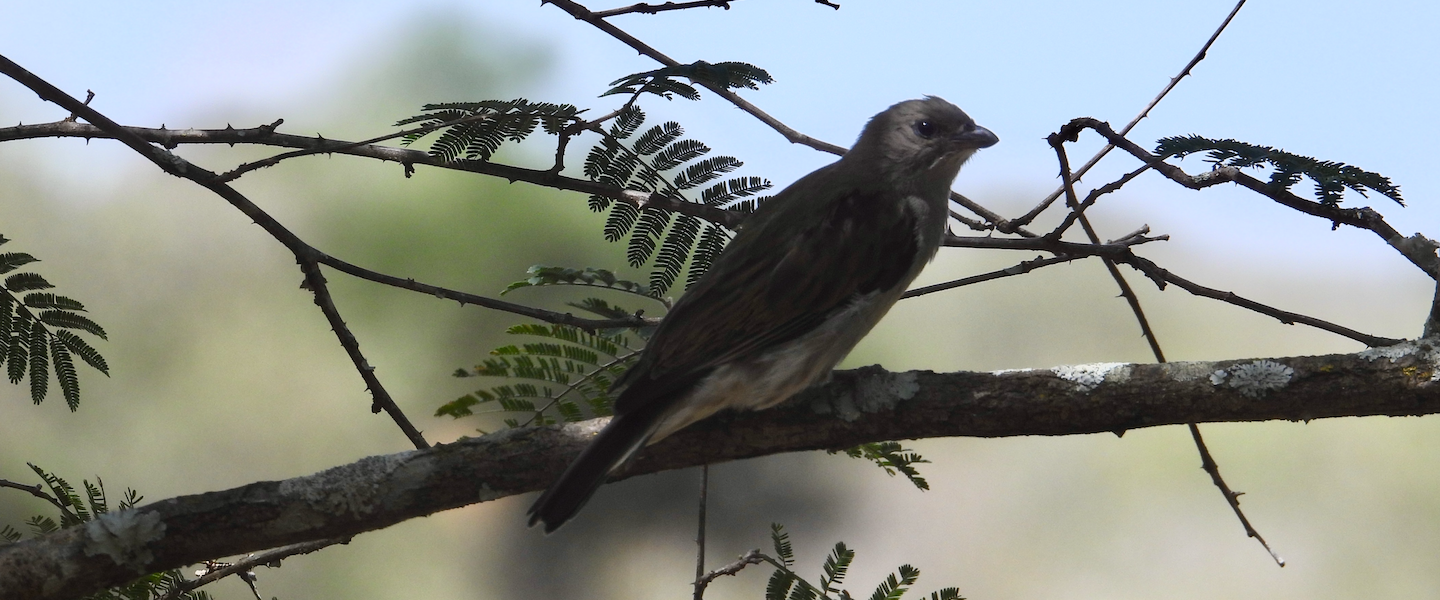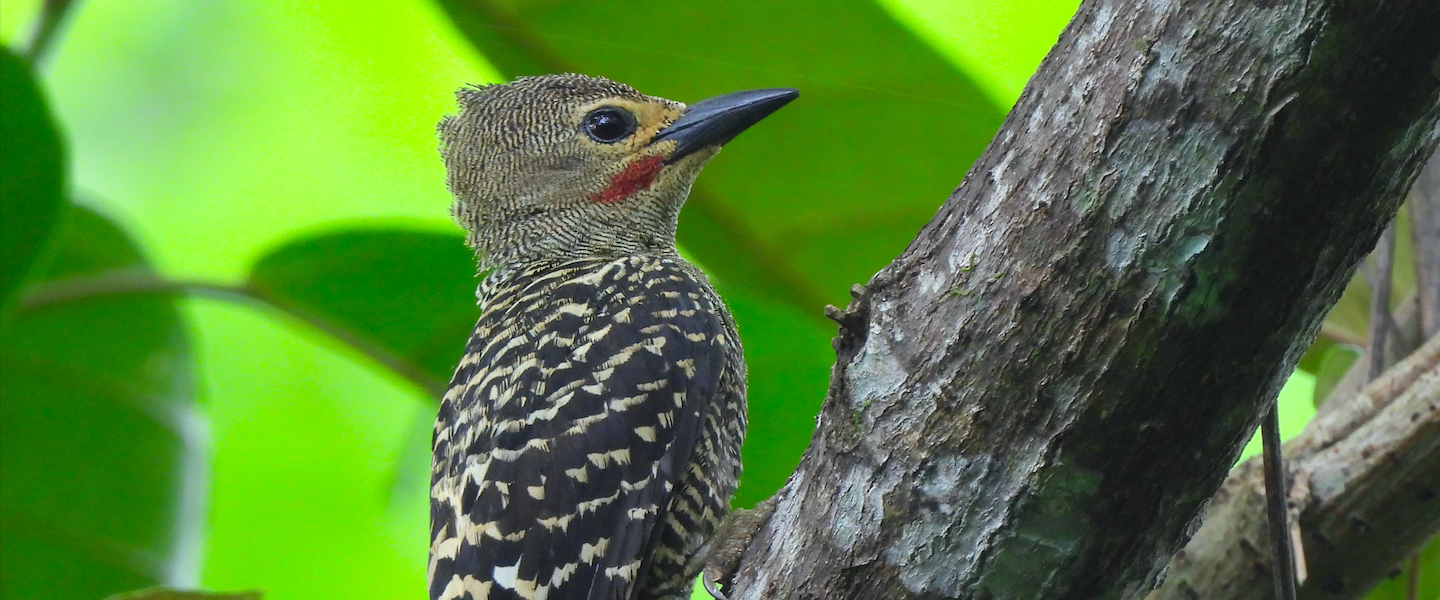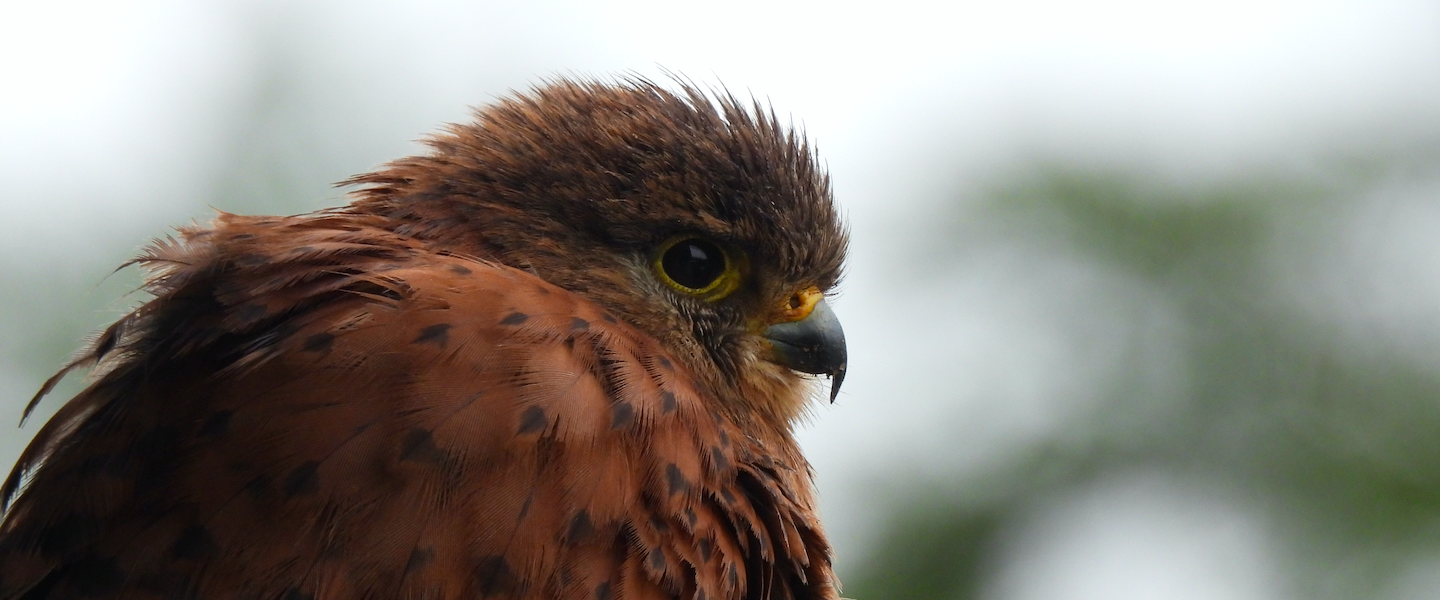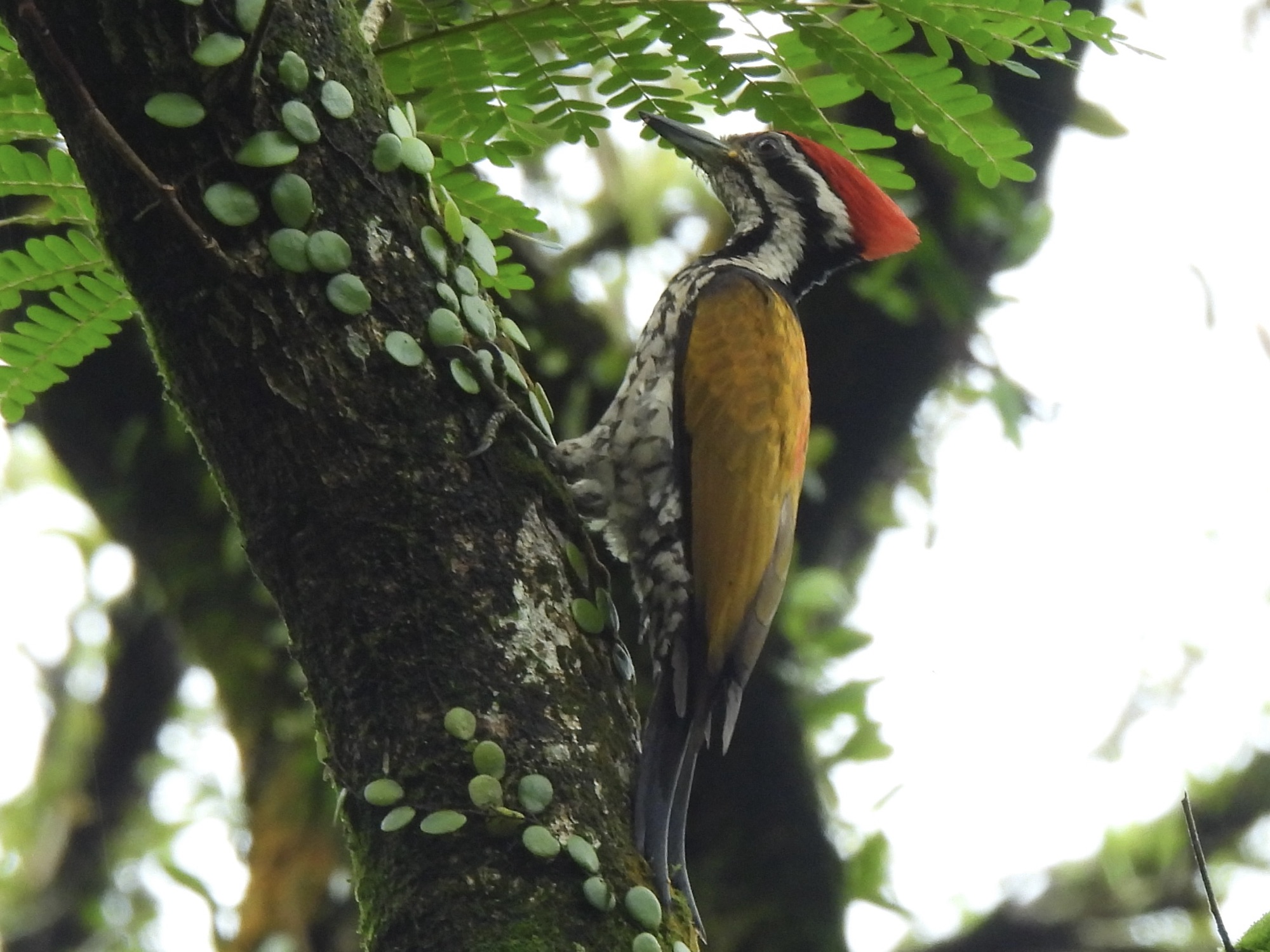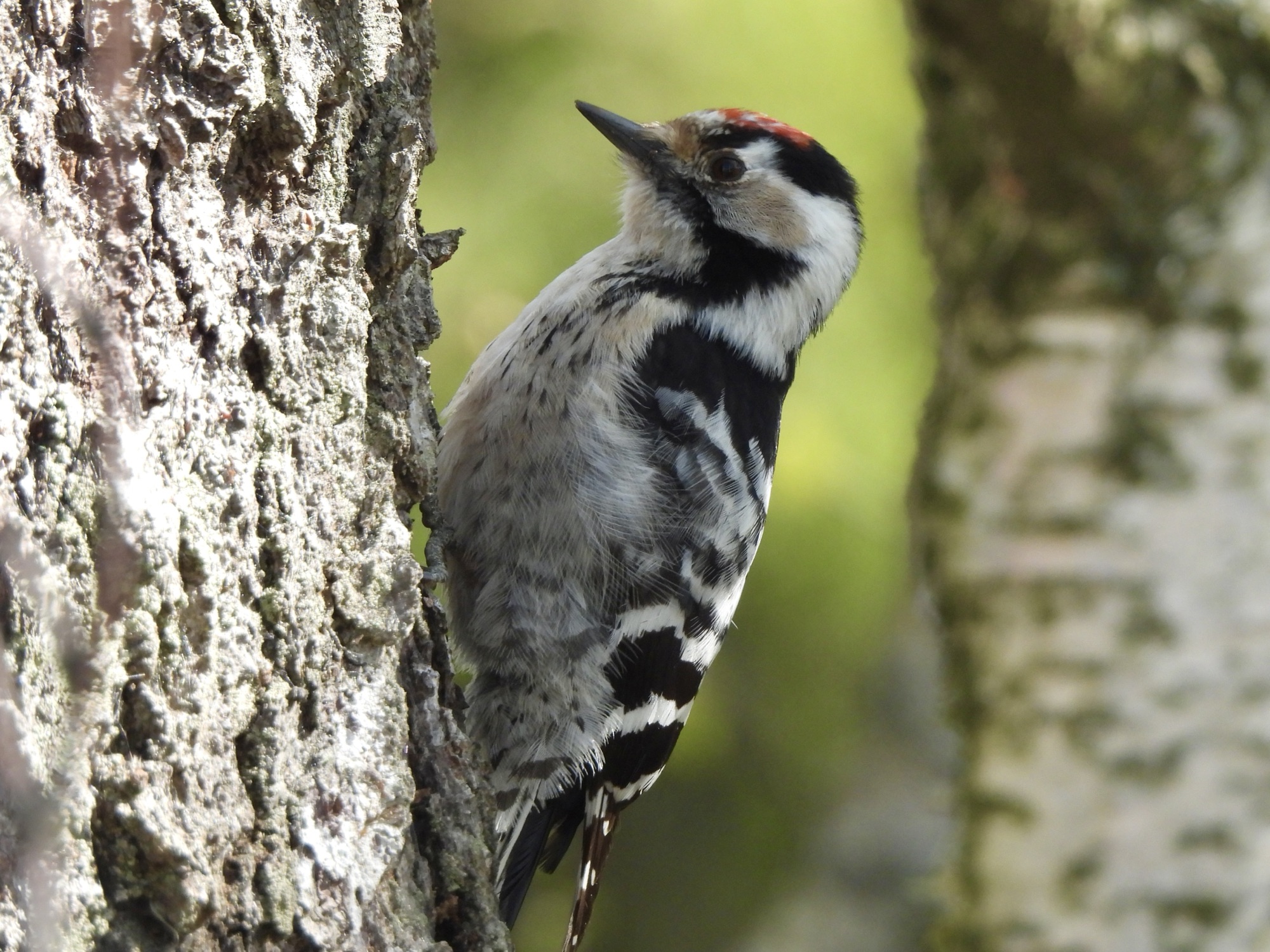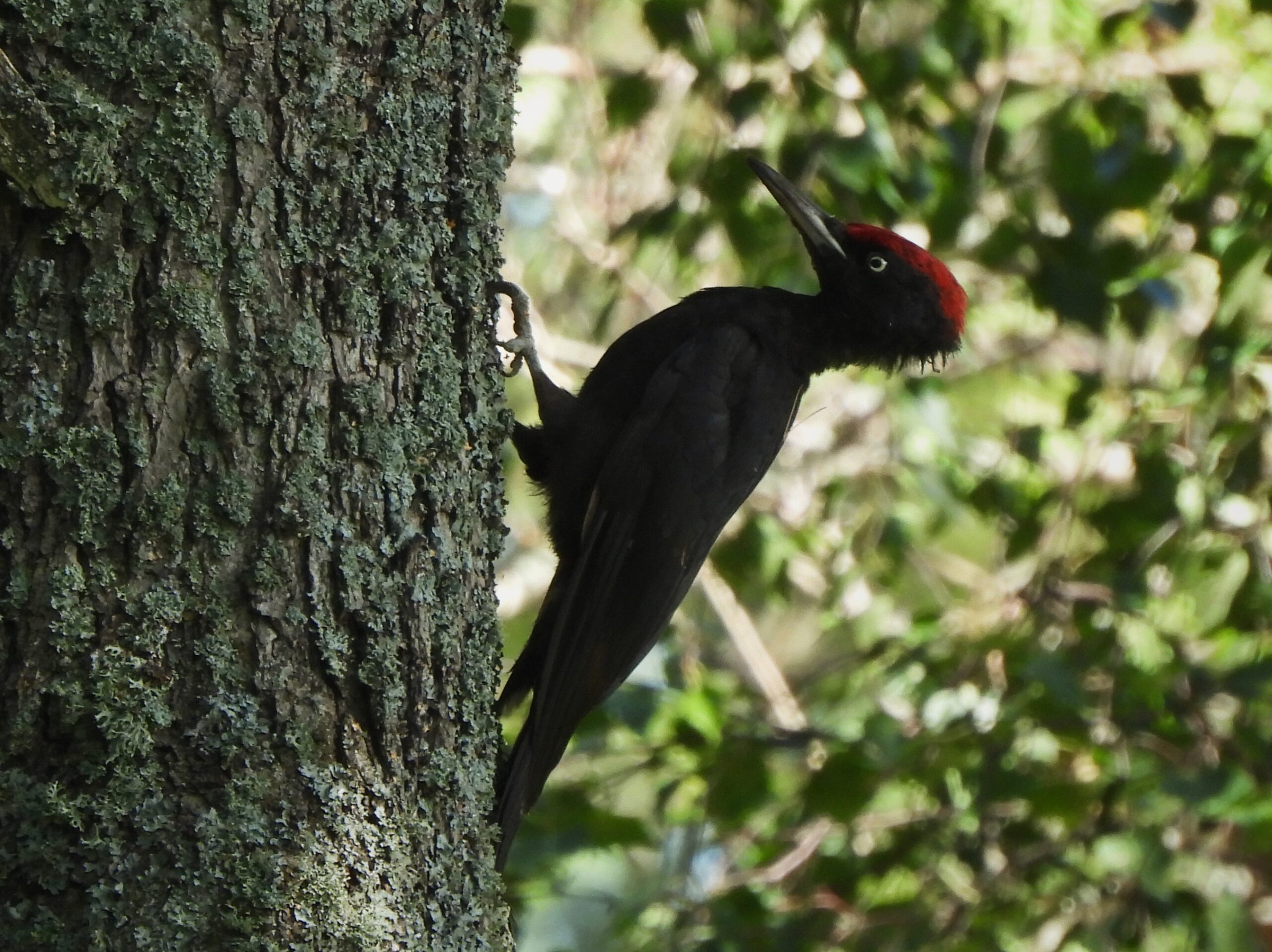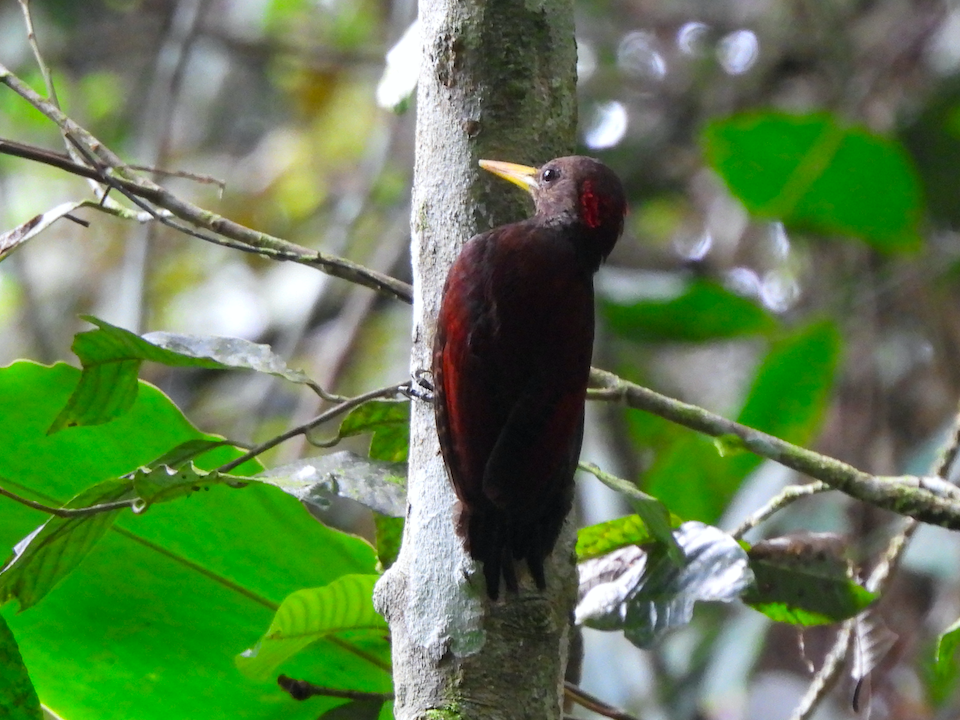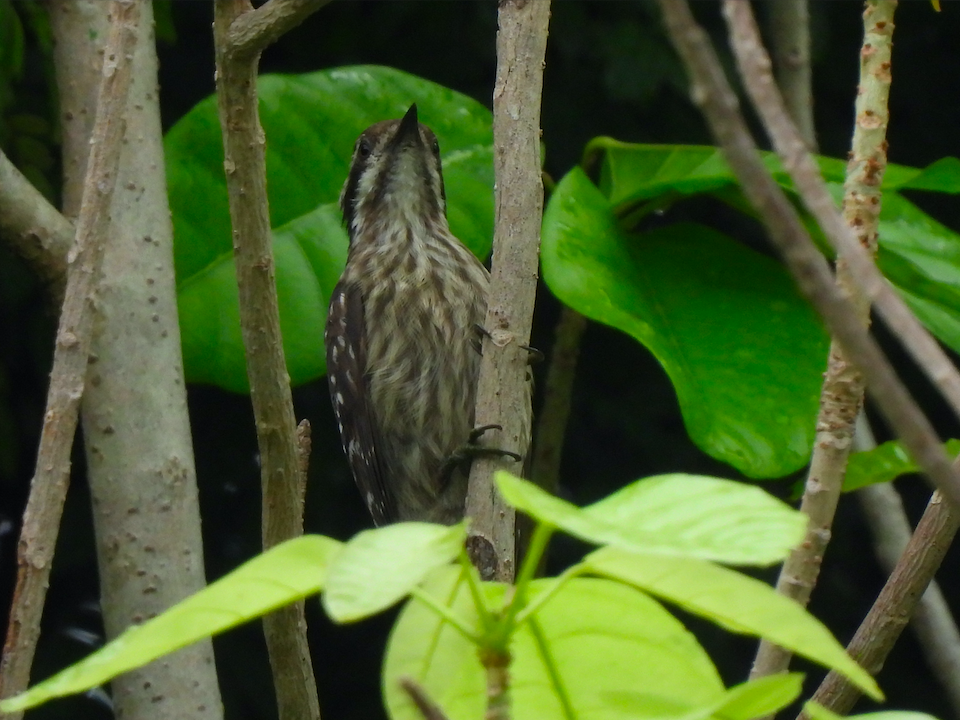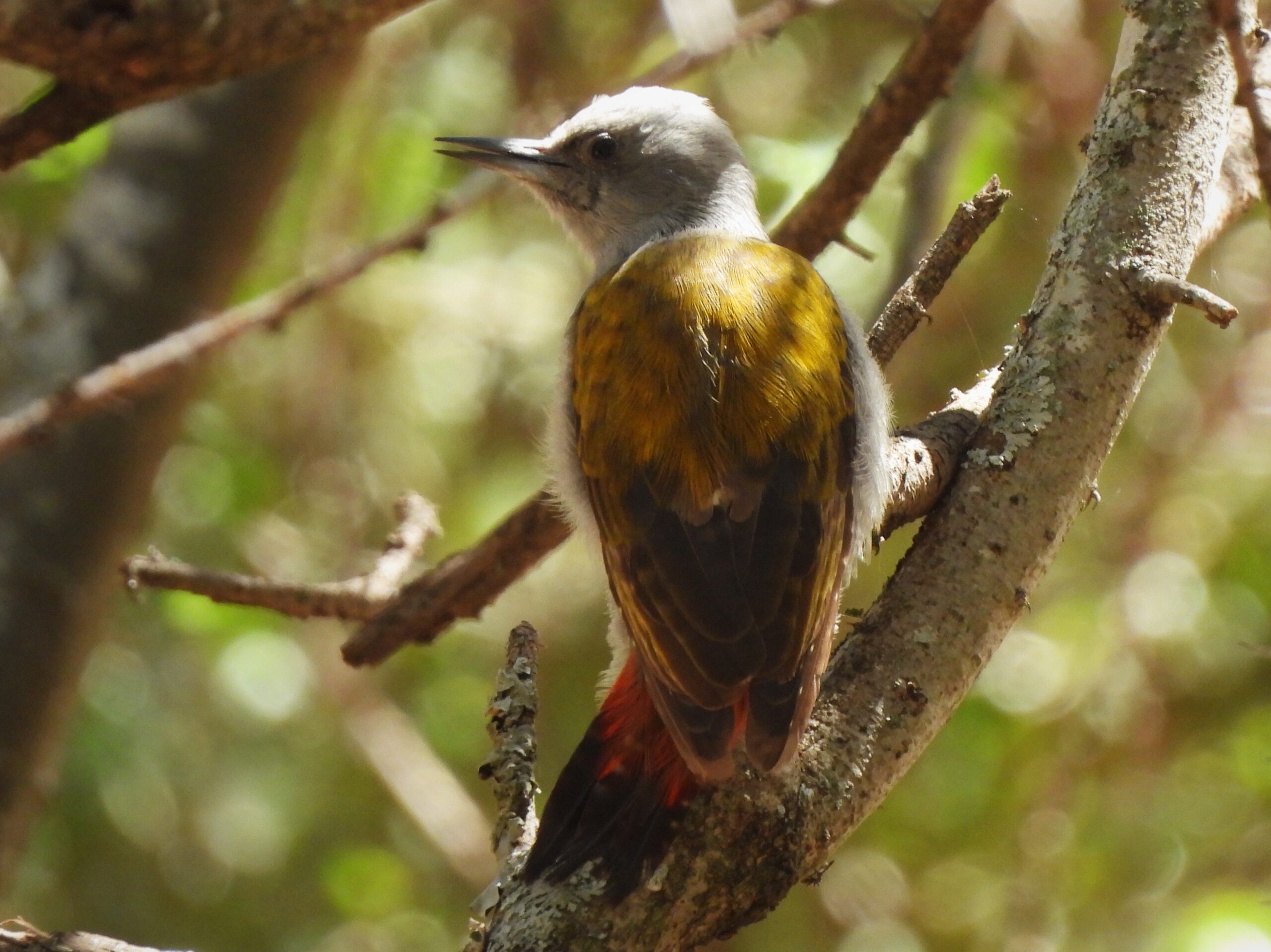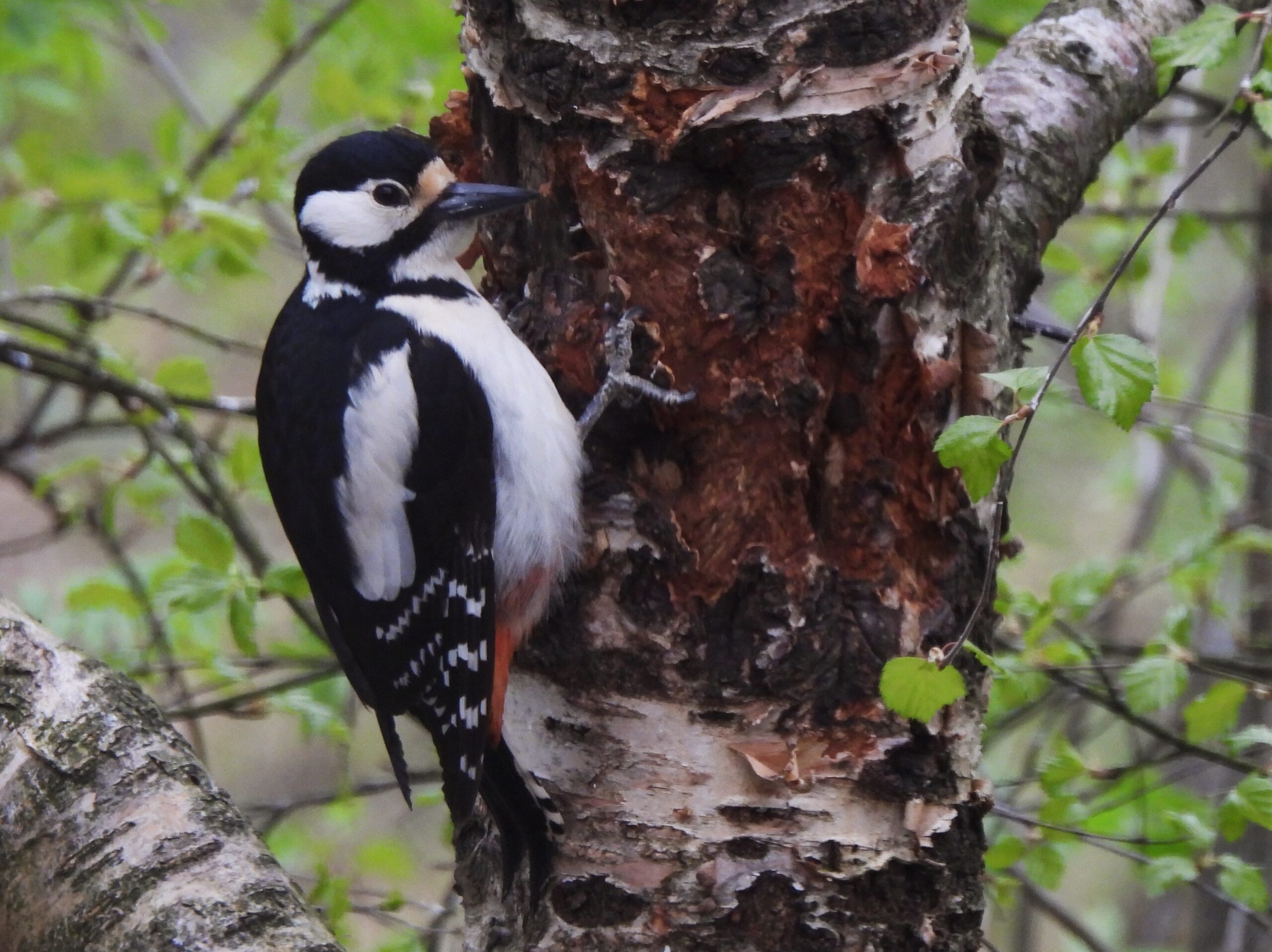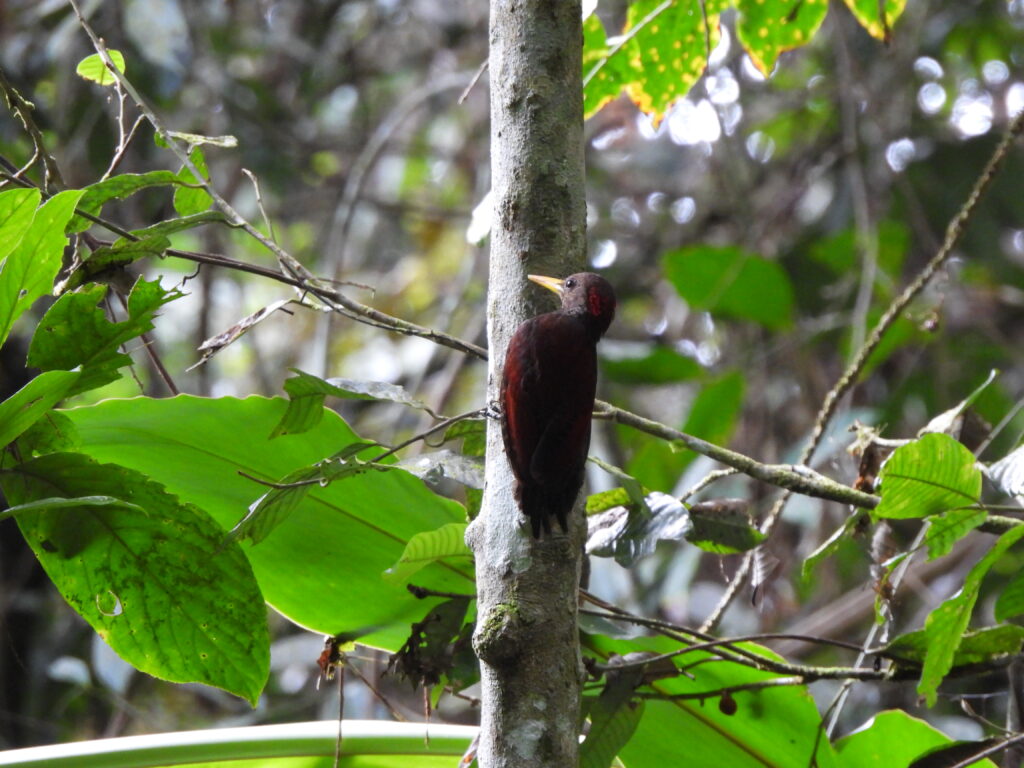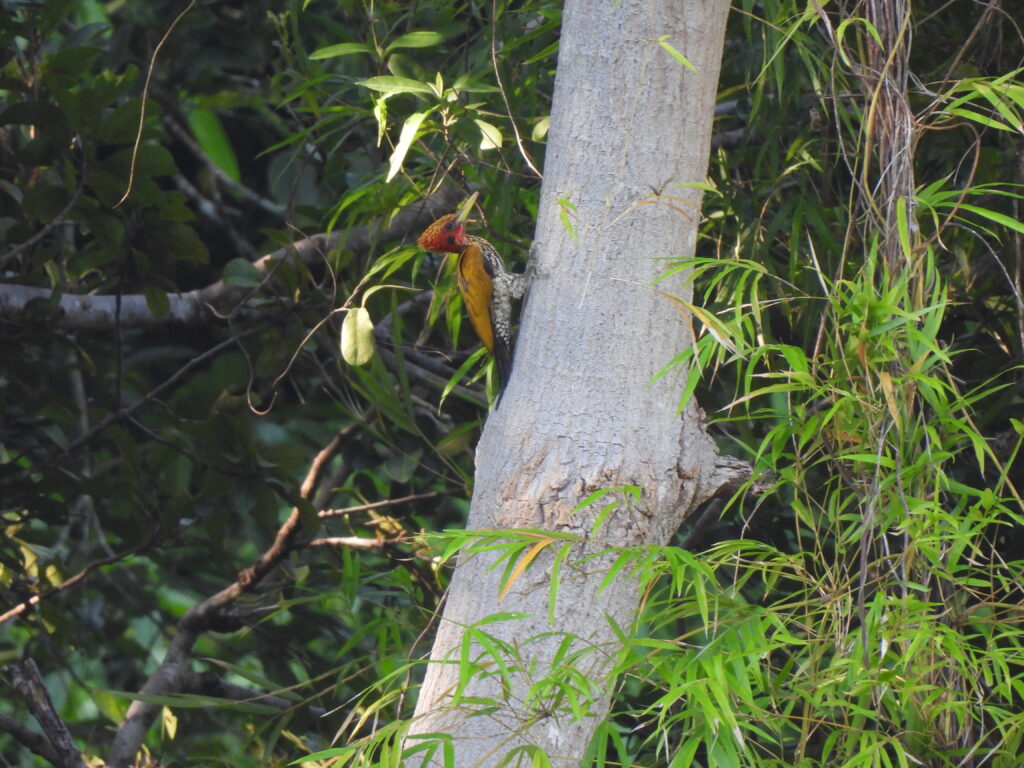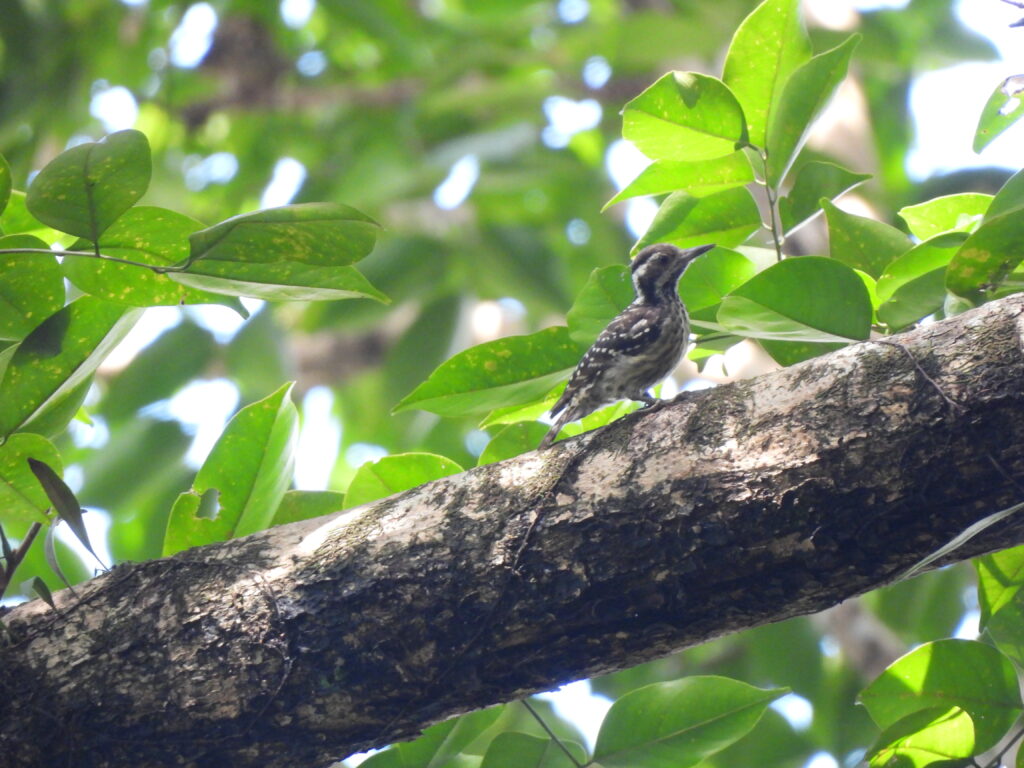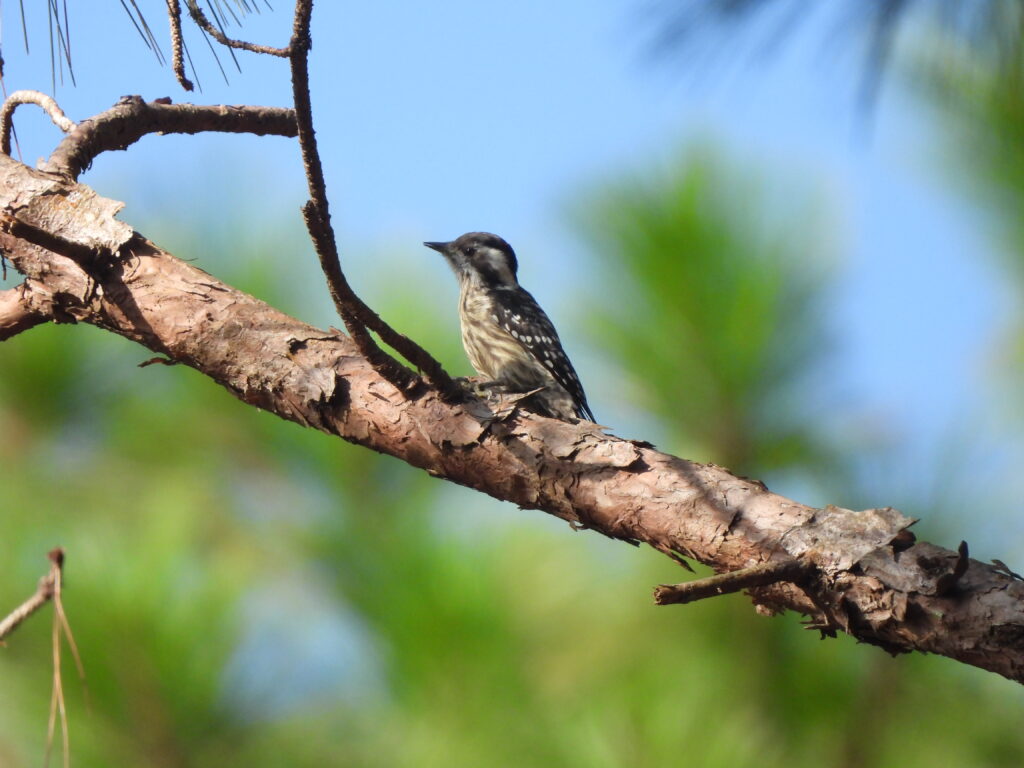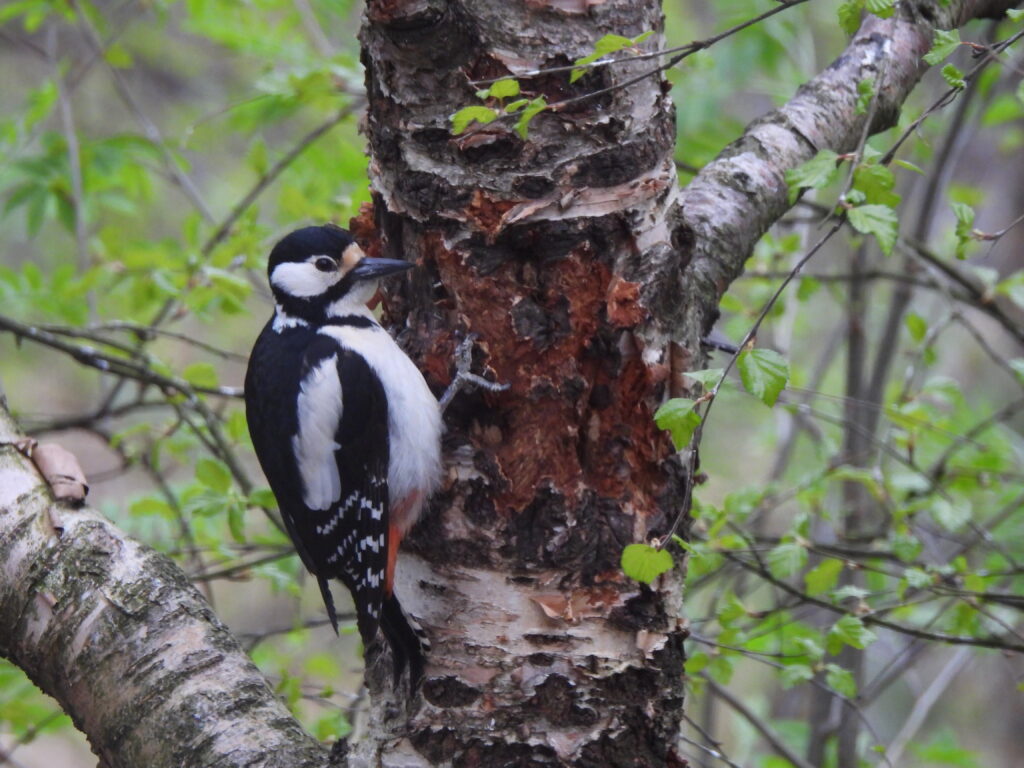The woodpeckers (family Picidae) are a family of birds belonging to the order Piciformes. They are found in forested areas (plus some terrestrial species in deserts and rocky habitats) worldwide, only being notoriously absent from Madagascar, Oceania and Antarctica. Woodpeckers are mostly acknowledged for their adaptation to capturing preys and carving holes in trees, with physical features that protect their brain when drumming. Indeed, drumming, along with generally loud laugh-like calls, are used for signaling and communication and can be used as ID features. Most species are solitary but some forage in pairs or engage in mixed-species foraging flocks. While sexes are generally similar, males of numerous species show red markings on the head that are absent on females — in some taxa, these heads have a notorious crest. A large, powerful bill, four-toed zygodactyl feet in most species and a stiff tail enhancing an upright posture while creeping trees are general features of most members of this family.
The family comprises 236 species in 36 genera. Basal genus Jynx (2 species) forms the unique subfamily Jynginae that includes the Old World wrynecks. Genera Picumnus (23 species), Verreauxia (1 species), Sasia (2 species) and Nesoctites (1 species) are generally known as piculets and conform the subfamily Picumninae.
All other woodpeckers belong to the subfamily Picinae. This first page aims to includes pictures of genera Hemicircus (2 species), Micropternus (1 species), Meiglyptes (4 species), Gecinulus (3 species), Dinopium (5 species), Picus (13 species), Chrysophlegma (3 species), Pardipicus (2 species), Geocolaptes (1 species), Campethera (10 species) and Mulleripicus (4 species).
The second page aims to include photos of genera Dryocopus (6 species), Celeus (12 species), Piculus (7 species), Colaptes (14 species of which 1 extinct), Campephilus (12 species of which 2 probably extinct), Blythipicus (2 species), Chrysocolaptes (10 species), Sphyrapicus (4 species), Xiphidiopicus (1 species), Melanerpes (23 species), Picoides (3 species), Yungipicus (7 species), Leiopicus (1 species), Dendrocoptes (3 species), Chloropicus (3 species), Dendropicos (12 species), Dendrocopos (12 species), Dryobates (6 species), Leuconotopicus (6 species) and Venilliornis (14 species).
Black woodpecker
Dryocopus martius
Largest woodpecker in Europe ranging east through Siberia to Hokkaido, preferrably in old-growth mixed forests but locally even in parks and gardens. Both sexes are jet black with a red cap, which is reduced to the back of the head in females. Best located by their singular calls in flight or and landing. This is an uncommon resident in Helsinki.
White-bellied woodpecker
Dryocopus javensis
Large woodpecker which favors tropical rainforests with plenty of dead wood and occurs locally throughout Southeast Asia, the Western Ghats, Sri Lanka and the Philippines. Males show an all-red crest, whereas red is restricted to the back of the head in females. I have seen this species in India and in Palawan in the Philippines.
Maroon woodpecker
Blythipicus rubiginosus
Found in forests at different altitudes in the Malay Peninsula, Borneo and Sumatra, where it often forages close to the ground. This species often joins mixed-species foraging flocks. The ivory-like bright-yellow bill contrasts with the overall reddish plumage. I have observed this species in Bukit Fraser in Malaysia.
Malabar flameback
Chrysocolaptes socialis
Large woodpecker endemic to wet lowland and foothill forests of the Western Ghats in India. Albeit superficially similar to the ‘short-billed’ flamebacks, they are not that related. In addition, this species (and its whole genus) is larger in size and has a much larger bill. I have seen this species in India.
Red-headed flameback
Chrysocolaptes erythrocephalus
Large woodpecker endemic to Palawan and neighboring islands, where it is a rare inhabitant of woodlands and forest edge. Head is bright red in males and spotted in females, but both sexes show a black ear spot and a large ivory-like yellow bill. I have observed this species on a trip to the Philippines.
Philippine pygmy woodpecker
Yungipicus maculatus
Small woodpecker of lowland and foothill forests and open woodlands endemic to the Philippine archipelago. Both sexes look alike except for a red marking on the head only present in males. I have seen this species near Manila in the Philippines.
Brown-capped pygmy woodpecker
Yungipicus nanus
Small woodpecker endemic to the Indian Subcontinent, mostly found in forest edge and open woodlands. This species shows clinal variation, with palest individual at the north end of their range in northern India and Nepal and darkest birds in Sri Lanka. I have encountered this species in India.
Sunda pygmy woodpecker
Yungipicus moluccensis
Diminutive woodpecker found in a wide range of wooded areas, from rainforests to urban gardens, in Sundaland from the Malay Peninsula east to the Lesser Sunda islands. As other woodpeckers, males show a small red marking at the back of their head. I have seen this species in Singapore and Borneo.
Gray-capped pygmy woodpecker
Yungipicus canicapillus
Small woodpecker found in mixed deciduous and mixed forests and gardens throughout Southeast and East Asia, from the Himalayas to Russian Far East south to Borneo and Sumatra. The namesake gray cap is only present in the populations of the north and end of its range. I have observed this species in Vietnam.
Middle spotted woodpecker
Dendrocoptes medius
Found mostly in Central Europe, where it almost exclusively inhabits old-growth oak forests. Its name refers to its size as compared to superficially similar woodpeckers of genera Dryobates and Dendrocopos co-occurring in European forests, although both sexes are similar and show a full red crown unlike those species. I have seen this species in Greece.
Eastern gray woodpecker
Dendropicos spodocephalus
Beautiful woodpecker of middle elevation savanna and woodlands of Ethiopia, Kenya and Tanzania. Overall light gray with golden-green wings and a red patch in the rump and vent, plus the crown in males. I have seen this species in Kenya.
Cardinal woodpecker
Dendropicos fuscescens
Small woodpecker found in a range of forested areas including savanna, open woodlands and riverine forests of most of Subsaharan Africa. Females show an all-black crown and nape, whereas males have a red marking on it. I have observed this species in Kenya.
White-backed woodpecker
Dendrocopos leucotos
Found in temperate deciduous and mixed old-growth forests across the Palearctic, where it occurs in low density and strongly relies on dead wood. Some isolated forms feature warmer plumages and might actually be separated taxa, including Southern Europe’s ‘Lilford’s‘ lilfordi and ‘Amani‘ owstoni. I have observed this species in Helsinki.
Great spotted woodpecker
Dendrocopos major
The most abundant woodpecker in Europe, where it occurs in most forest types including urban parks and gardens. Males show a small red marking at the back of the head, but juveniles sport a large red crown and a vent washed in reddish. This species is abundant all year round in Helsinki and is a local, uncommon but increasing resident in riverine forests in Alicante.
Syrian woodpecker
Dendrocopos syriacus
Found in relatively open woodlands of Eastern Europe and Middle East. Very similar relative of the great spotted woodpecker with subtle but diagnostic differences in calls, drumming and morphology — such as an incomplete neck black band. I have seen this species in Greece.
Lesser spotted woodpecker
Dryobates minor
Distributed along deciduous forests and large gardens and grooves throughout the Palearctic, from the Iberian Peninsula to Hokkaido. Smallest woodpecker in Europe, albeit size similar to other species outside its range. As in other members of the family, the red crown is unique to males. This species is an uncommon, inconspicuous resident in Helsinki.

